London Transport: Meeting the Challenges of Rush Hour Demand
VerifiedAdded on 2024/05/20
|8
|2358
|135
AI Summary
This research delves into the complexities of London's transportation system, focusing on the challenges of meeting passenger demand during peak hours. It examines the historical evolution of London transport, analyzes the current state of the network, and identifies key issues related to congestion, capacity, and service quality. Drawing on secondary data sources, including government reports, academic publications, and industry data, the research explores potential solutions to improve the efficiency and effectiveness of London's transport system during rush hours. The study highlights the importance of integrated planning, technological advancements, and innovative strategies to ensure a seamless and reliable travel experience for Londoners and visitors alike.
Contribute Materials
Your contribution can guide someone’s learning journey. Share your
documents today.
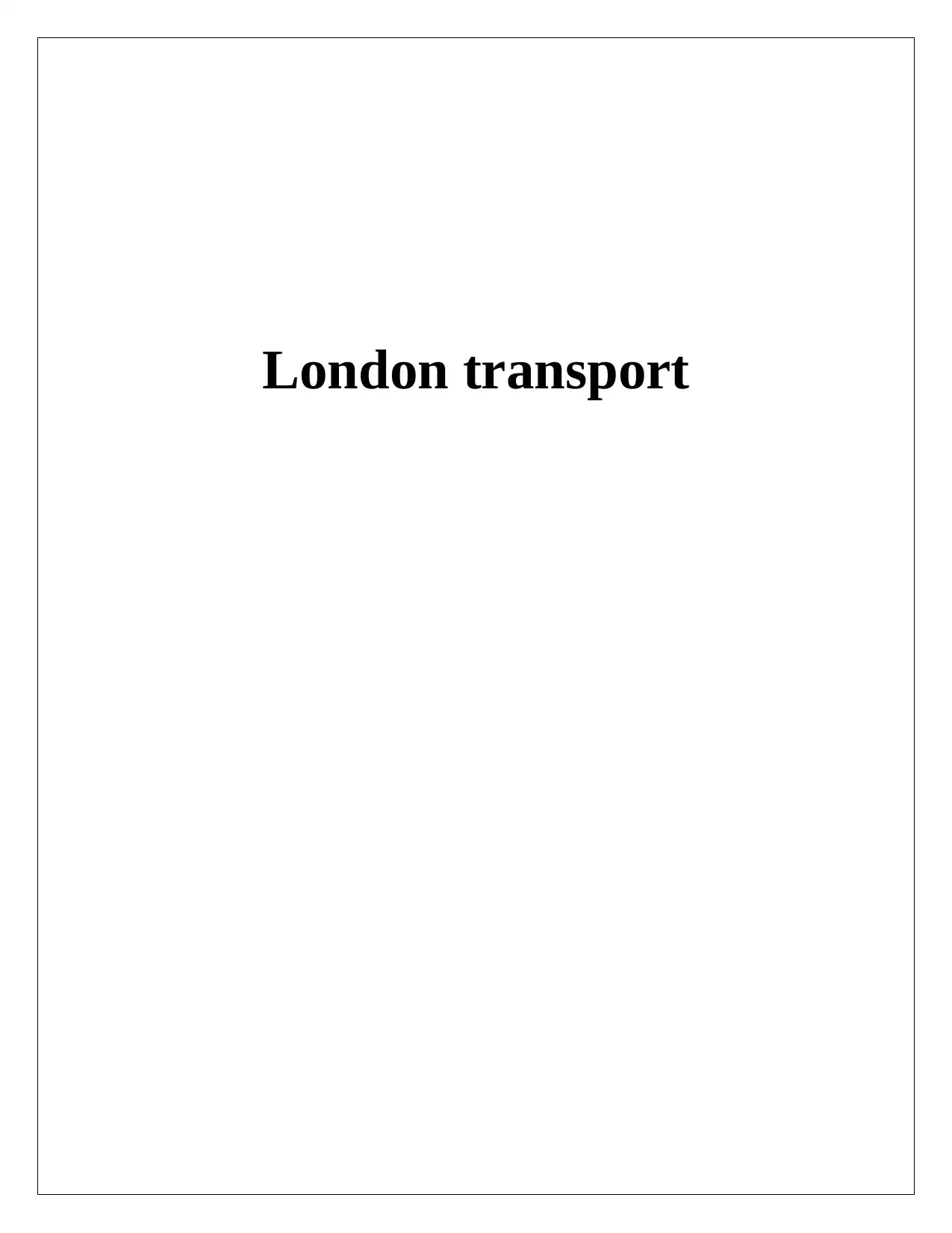
London transport
Secure Best Marks with AI Grader
Need help grading? Try our AI Grader for instant feedback on your assignments.
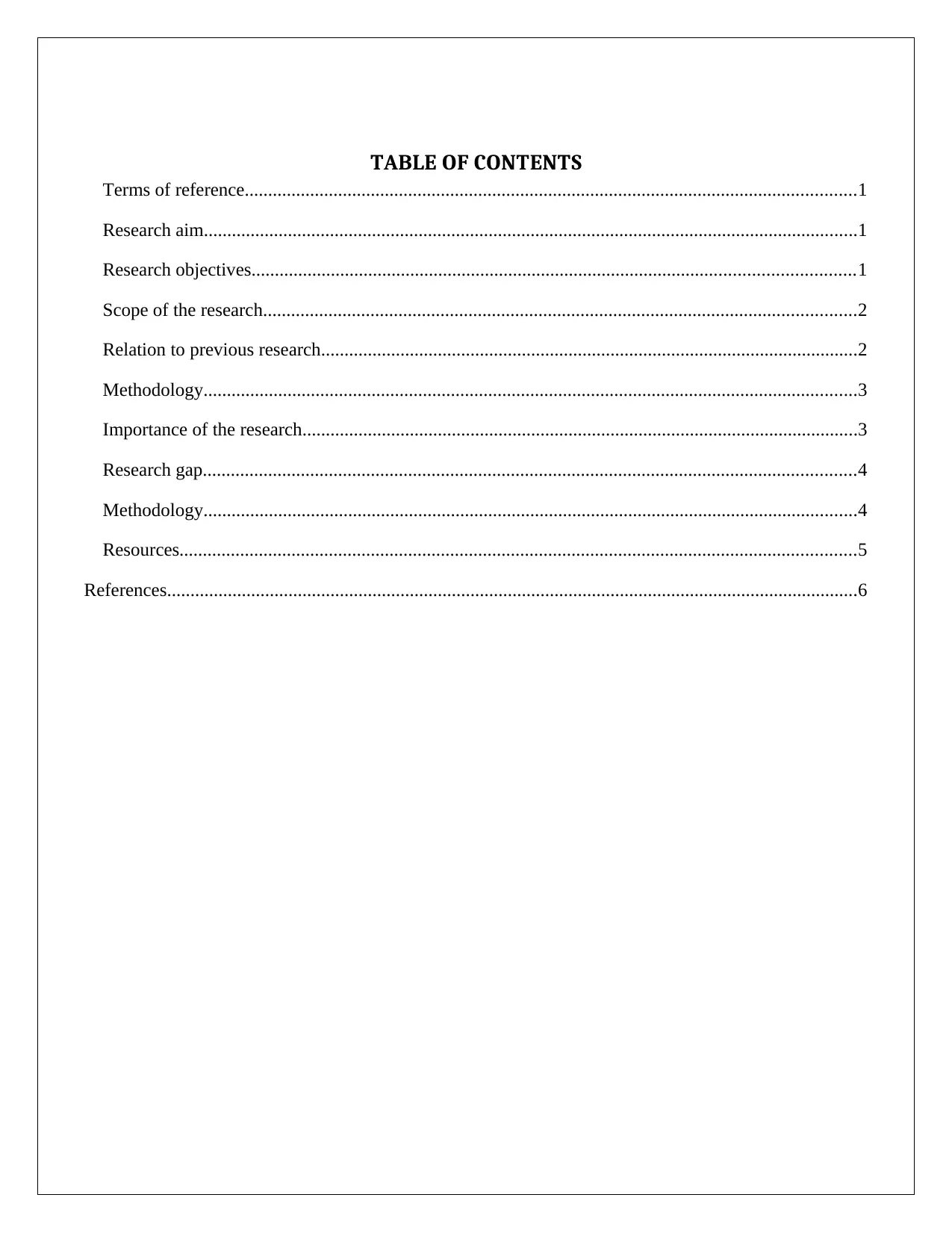
TABLE OF CONTENTS
Terms of reference...................................................................................................................................1
Research aim............................................................................................................................................1
Research objectives.................................................................................................................................1
Scope of the research...............................................................................................................................2
Relation to previous research...................................................................................................................2
Methodology............................................................................................................................................3
Importance of the research.......................................................................................................................3
Research gap............................................................................................................................................4
Methodology............................................................................................................................................4
Resources.................................................................................................................................................5
References....................................................................................................................................................6
Terms of reference...................................................................................................................................1
Research aim............................................................................................................................................1
Research objectives.................................................................................................................................1
Scope of the research...............................................................................................................................2
Relation to previous research...................................................................................................................2
Methodology............................................................................................................................................3
Importance of the research.......................................................................................................................3
Research gap............................................................................................................................................4
Methodology............................................................................................................................................4
Resources.................................................................................................................................................5
References....................................................................................................................................................6
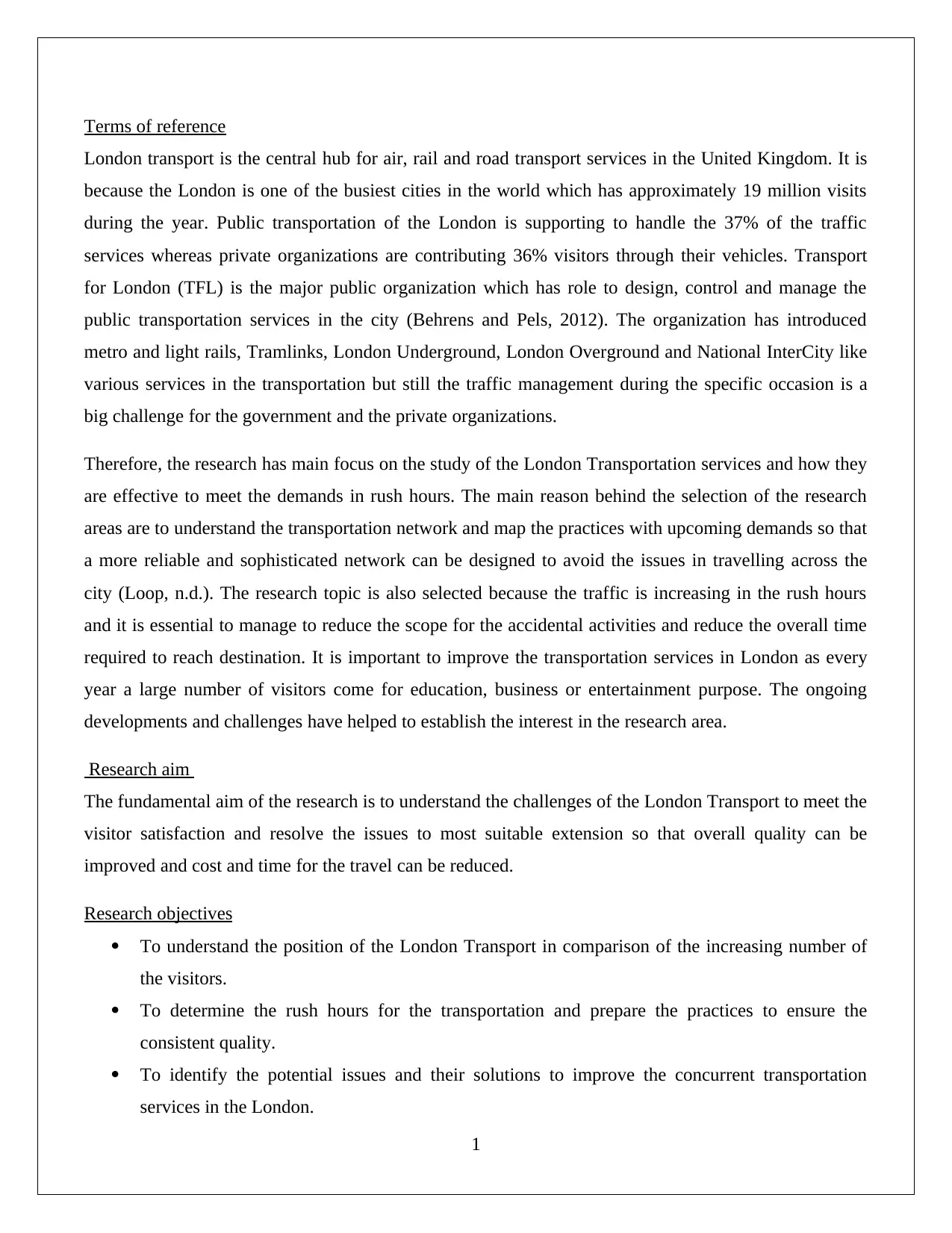
Terms of reference
London transport is the central hub for air, rail and road transport services in the United Kingdom. It is
because the London is one of the busiest cities in the world which has approximately 19 million visits
during the year. Public transportation of the London is supporting to handle the 37% of the traffic
services whereas private organizations are contributing 36% visitors through their vehicles. Transport
for London (TFL) is the major public organization which has role to design, control and manage the
public transportation services in the city (Behrens and Pels, 2012). The organization has introduced
metro and light rails, Tramlinks, London Underground, London Overground and National InterCity like
various services in the transportation but still the traffic management during the specific occasion is a
big challenge for the government and the private organizations.
Therefore, the research has main focus on the study of the London Transportation services and how they
are effective to meet the demands in rush hours. The main reason behind the selection of the research
areas are to understand the transportation network and map the practices with upcoming demands so that
a more reliable and sophisticated network can be designed to avoid the issues in travelling across the
city (Loop, n.d.). The research topic is also selected because the traffic is increasing in the rush hours
and it is essential to manage to reduce the scope for the accidental activities and reduce the overall time
required to reach destination. It is important to improve the transportation services in London as every
year a large number of visitors come for education, business or entertainment purpose. The ongoing
developments and challenges have helped to establish the interest in the research area.
Research aim
The fundamental aim of the research is to understand the challenges of the London Transport to meet the
visitor satisfaction and resolve the issues to most suitable extension so that overall quality can be
improved and cost and time for the travel can be reduced.
Research objectives
To understand the position of the London Transport in comparison of the increasing number of
the visitors.
To determine the rush hours for the transportation and prepare the practices to ensure the
consistent quality.
To identify the potential issues and their solutions to improve the concurrent transportation
services in the London.
1
London transport is the central hub for air, rail and road transport services in the United Kingdom. It is
because the London is one of the busiest cities in the world which has approximately 19 million visits
during the year. Public transportation of the London is supporting to handle the 37% of the traffic
services whereas private organizations are contributing 36% visitors through their vehicles. Transport
for London (TFL) is the major public organization which has role to design, control and manage the
public transportation services in the city (Behrens and Pels, 2012). The organization has introduced
metro and light rails, Tramlinks, London Underground, London Overground and National InterCity like
various services in the transportation but still the traffic management during the specific occasion is a
big challenge for the government and the private organizations.
Therefore, the research has main focus on the study of the London Transportation services and how they
are effective to meet the demands in rush hours. The main reason behind the selection of the research
areas are to understand the transportation network and map the practices with upcoming demands so that
a more reliable and sophisticated network can be designed to avoid the issues in travelling across the
city (Loop, n.d.). The research topic is also selected because the traffic is increasing in the rush hours
and it is essential to manage to reduce the scope for the accidental activities and reduce the overall time
required to reach destination. It is important to improve the transportation services in London as every
year a large number of visitors come for education, business or entertainment purpose. The ongoing
developments and challenges have helped to establish the interest in the research area.
Research aim
The fundamental aim of the research is to understand the challenges of the London Transport to meet the
visitor satisfaction and resolve the issues to most suitable extension so that overall quality can be
improved and cost and time for the travel can be reduced.
Research objectives
To understand the position of the London Transport in comparison of the increasing number of
the visitors.
To determine the rush hours for the transportation and prepare the practices to ensure the
consistent quality.
To identify the potential issues and their solutions to improve the concurrent transportation
services in the London.
1
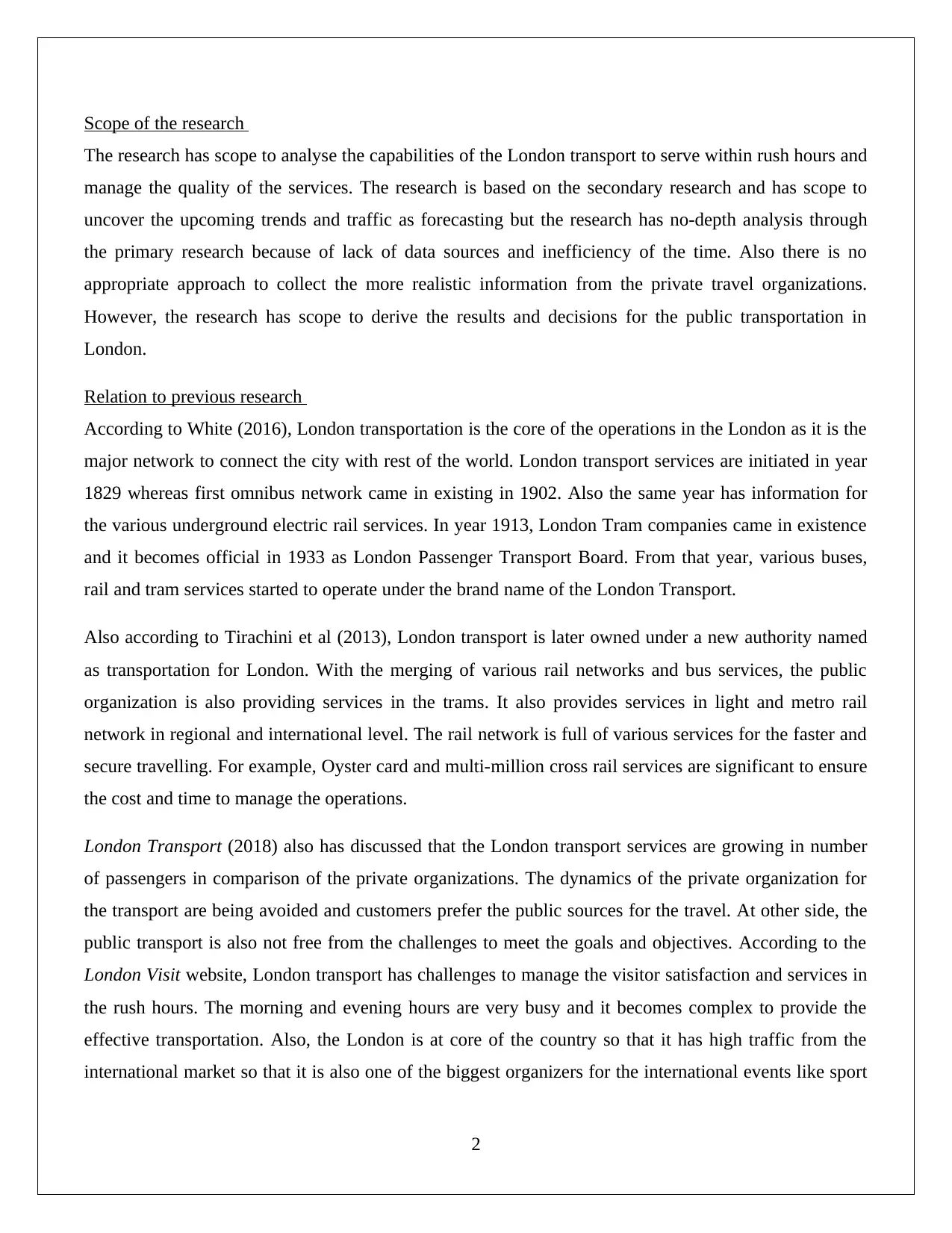
Scope of the research
The research has scope to analyse the capabilities of the London transport to serve within rush hours and
manage the quality of the services. The research is based on the secondary research and has scope to
uncover the upcoming trends and traffic as forecasting but the research has no-depth analysis through
the primary research because of lack of data sources and inefficiency of the time. Also there is no
appropriate approach to collect the more realistic information from the private travel organizations.
However, the research has scope to derive the results and decisions for the public transportation in
London.
Relation to previous research
According to White (2016), London transportation is the core of the operations in the London as it is the
major network to connect the city with rest of the world. London transport services are initiated in year
1829 whereas first omnibus network came in existing in 1902. Also the same year has information for
the various underground electric rail services. In year 1913, London Tram companies came in existence
and it becomes official in 1933 as London Passenger Transport Board. From that year, various buses,
rail and tram services started to operate under the brand name of the London Transport.
Also according to Tirachini et al (2013), London transport is later owned under a new authority named
as transportation for London. With the merging of various rail networks and bus services, the public
organization is also providing services in the trams. It also provides services in light and metro rail
network in regional and international level. The rail network is full of various services for the faster and
secure travelling. For example, Oyster card and multi-million cross rail services are significant to ensure
the cost and time to manage the operations.
London Transport (2018) also has discussed that the London transport services are growing in number
of passengers in comparison of the private organizations. The dynamics of the private organization for
the transport are being avoided and customers prefer the public sources for the travel. At other side, the
public transport is also not free from the challenges to meet the goals and objectives. According to the
London Visit website, London transport has challenges to manage the visitor satisfaction and services in
the rush hours. The morning and evening hours are very busy and it becomes complex to provide the
effective transportation. Also, the London is at core of the country so that it has high traffic from the
international market so that it is also one of the biggest organizers for the international events like sport
2
The research has scope to analyse the capabilities of the London transport to serve within rush hours and
manage the quality of the services. The research is based on the secondary research and has scope to
uncover the upcoming trends and traffic as forecasting but the research has no-depth analysis through
the primary research because of lack of data sources and inefficiency of the time. Also there is no
appropriate approach to collect the more realistic information from the private travel organizations.
However, the research has scope to derive the results and decisions for the public transportation in
London.
Relation to previous research
According to White (2016), London transportation is the core of the operations in the London as it is the
major network to connect the city with rest of the world. London transport services are initiated in year
1829 whereas first omnibus network came in existing in 1902. Also the same year has information for
the various underground electric rail services. In year 1913, London Tram companies came in existence
and it becomes official in 1933 as London Passenger Transport Board. From that year, various buses,
rail and tram services started to operate under the brand name of the London Transport.
Also according to Tirachini et al (2013), London transport is later owned under a new authority named
as transportation for London. With the merging of various rail networks and bus services, the public
organization is also providing services in the trams. It also provides services in light and metro rail
network in regional and international level. The rail network is full of various services for the faster and
secure travelling. For example, Oyster card and multi-million cross rail services are significant to ensure
the cost and time to manage the operations.
London Transport (2018) also has discussed that the London transport services are growing in number
of passengers in comparison of the private organizations. The dynamics of the private organization for
the transport are being avoided and customers prefer the public sources for the travel. At other side, the
public transport is also not free from the challenges to meet the goals and objectives. According to the
London Visit website, London transport has challenges to manage the visitor satisfaction and services in
the rush hours. The morning and evening hours are very busy and it becomes complex to provide the
effective transportation. Also, the London is at core of the country so that it has high traffic from the
international market so that it is also one of the biggest organizers for the international events like sport
2
Secure Best Marks with AI Grader
Need help grading? Try our AI Grader for instant feedback on your assignments.
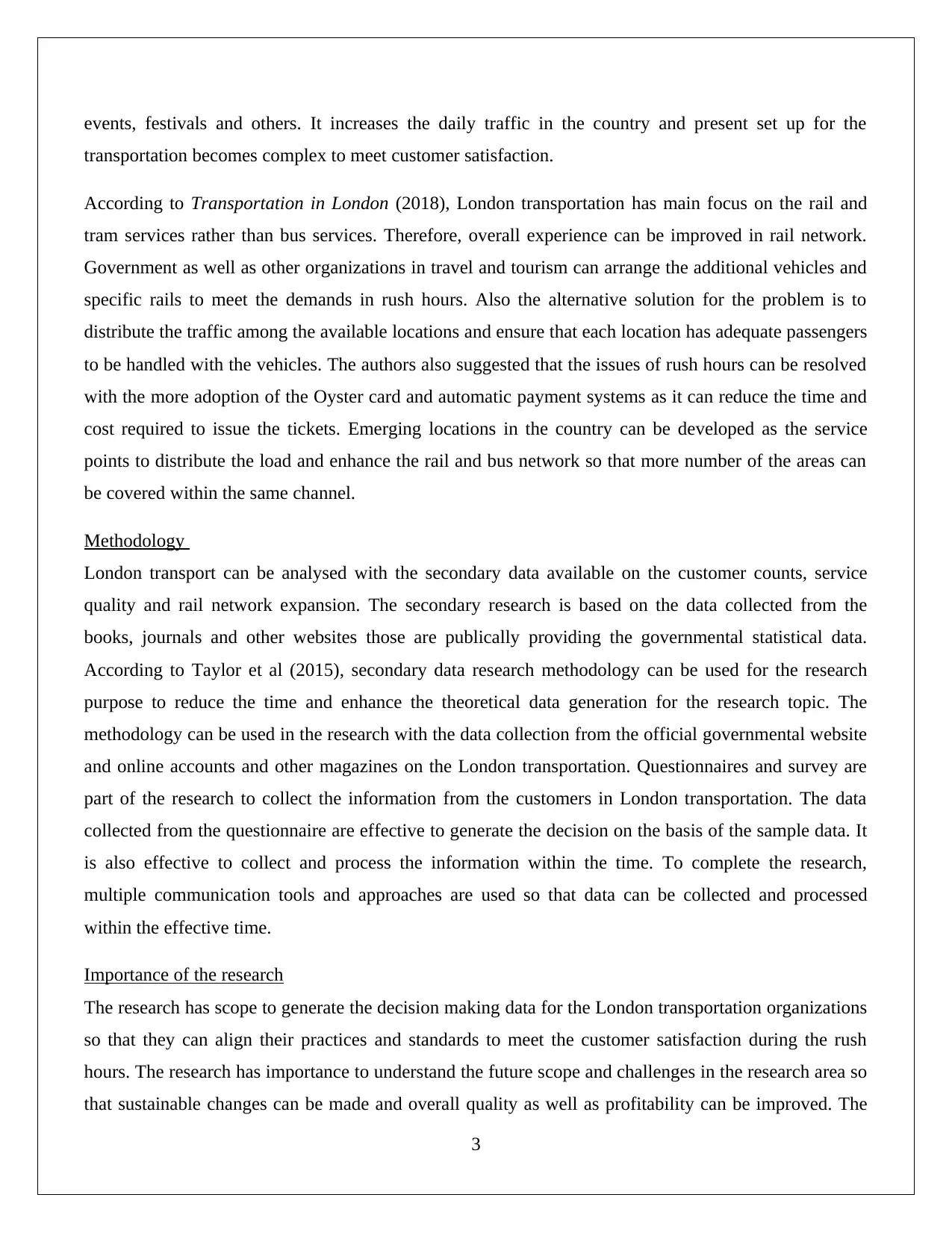
events, festivals and others. It increases the daily traffic in the country and present set up for the
transportation becomes complex to meet customer satisfaction.
According to Transportation in London (2018), London transportation has main focus on the rail and
tram services rather than bus services. Therefore, overall experience can be improved in rail network.
Government as well as other organizations in travel and tourism can arrange the additional vehicles and
specific rails to meet the demands in rush hours. Also the alternative solution for the problem is to
distribute the traffic among the available locations and ensure that each location has adequate passengers
to be handled with the vehicles. The authors also suggested that the issues of rush hours can be resolved
with the more adoption of the Oyster card and automatic payment systems as it can reduce the time and
cost required to issue the tickets. Emerging locations in the country can be developed as the service
points to distribute the load and enhance the rail and bus network so that more number of the areas can
be covered within the same channel.
Methodology
London transport can be analysed with the secondary data available on the customer counts, service
quality and rail network expansion. The secondary research is based on the data collected from the
books, journals and other websites those are publically providing the governmental statistical data.
According to Taylor et al (2015), secondary data research methodology can be used for the research
purpose to reduce the time and enhance the theoretical data generation for the research topic. The
methodology can be used in the research with the data collection from the official governmental website
and online accounts and other magazines on the London transportation. Questionnaires and survey are
part of the research to collect the information from the customers in London transportation. The data
collected from the questionnaire are effective to generate the decision on the basis of the sample data. It
is also effective to collect and process the information within the time. To complete the research,
multiple communication tools and approaches are used so that data can be collected and processed
within the effective time.
Importance of the research
The research has scope to generate the decision making data for the London transportation organizations
so that they can align their practices and standards to meet the customer satisfaction during the rush
hours. The research has importance to understand the future scope and challenges in the research area so
that sustainable changes can be made and overall quality as well as profitability can be improved. The
3
transportation becomes complex to meet customer satisfaction.
According to Transportation in London (2018), London transportation has main focus on the rail and
tram services rather than bus services. Therefore, overall experience can be improved in rail network.
Government as well as other organizations in travel and tourism can arrange the additional vehicles and
specific rails to meet the demands in rush hours. Also the alternative solution for the problem is to
distribute the traffic among the available locations and ensure that each location has adequate passengers
to be handled with the vehicles. The authors also suggested that the issues of rush hours can be resolved
with the more adoption of the Oyster card and automatic payment systems as it can reduce the time and
cost required to issue the tickets. Emerging locations in the country can be developed as the service
points to distribute the load and enhance the rail and bus network so that more number of the areas can
be covered within the same channel.
Methodology
London transport can be analysed with the secondary data available on the customer counts, service
quality and rail network expansion. The secondary research is based on the data collected from the
books, journals and other websites those are publically providing the governmental statistical data.
According to Taylor et al (2015), secondary data research methodology can be used for the research
purpose to reduce the time and enhance the theoretical data generation for the research topic. The
methodology can be used in the research with the data collection from the official governmental website
and online accounts and other magazines on the London transportation. Questionnaires and survey are
part of the research to collect the information from the customers in London transportation. The data
collected from the questionnaire are effective to generate the decision on the basis of the sample data. It
is also effective to collect and process the information within the time. To complete the research,
multiple communication tools and approaches are used so that data can be collected and processed
within the effective time.
Importance of the research
The research has scope to generate the decision making data for the London transportation organizations
so that they can align their practices and standards to meet the customer satisfaction during the rush
hours. The research has importance to understand the future scope and challenges in the research area so
that sustainable changes can be made and overall quality as well as profitability can be improved. The
3
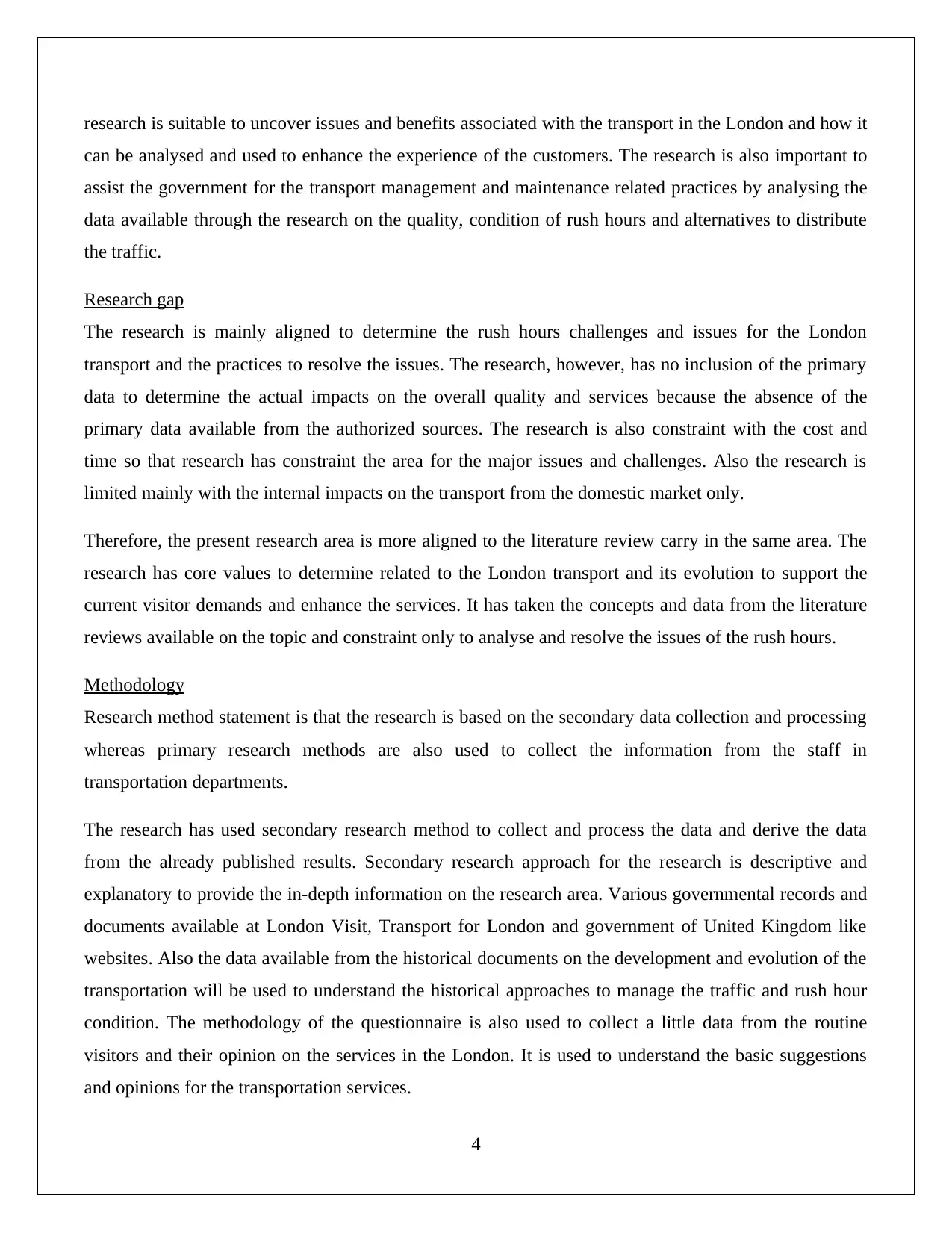
research is suitable to uncover issues and benefits associated with the transport in the London and how it
can be analysed and used to enhance the experience of the customers. The research is also important to
assist the government for the transport management and maintenance related practices by analysing the
data available through the research on the quality, condition of rush hours and alternatives to distribute
the traffic.
Research gap
The research is mainly aligned to determine the rush hours challenges and issues for the London
transport and the practices to resolve the issues. The research, however, has no inclusion of the primary
data to determine the actual impacts on the overall quality and services because the absence of the
primary data available from the authorized sources. The research is also constraint with the cost and
time so that research has constraint the area for the major issues and challenges. Also the research is
limited mainly with the internal impacts on the transport from the domestic market only.
Therefore, the present research area is more aligned to the literature review carry in the same area. The
research has core values to determine related to the London transport and its evolution to support the
current visitor demands and enhance the services. It has taken the concepts and data from the literature
reviews available on the topic and constraint only to analyse and resolve the issues of the rush hours.
Methodology
Research method statement is that the research is based on the secondary data collection and processing
whereas primary research methods are also used to collect the information from the staff in
transportation departments.
The research has used secondary research method to collect and process the data and derive the data
from the already published results. Secondary research approach for the research is descriptive and
explanatory to provide the in-depth information on the research area. Various governmental records and
documents available at London Visit, Transport for London and government of United Kingdom like
websites. Also the data available from the historical documents on the development and evolution of the
transportation will be used to understand the historical approaches to manage the traffic and rush hour
condition. The methodology of the questionnaire is also used to collect a little data from the routine
visitors and their opinion on the services in the London. It is used to understand the basic suggestions
and opinions for the transportation services.
4
can be analysed and used to enhance the experience of the customers. The research is also important to
assist the government for the transport management and maintenance related practices by analysing the
data available through the research on the quality, condition of rush hours and alternatives to distribute
the traffic.
Research gap
The research is mainly aligned to determine the rush hours challenges and issues for the London
transport and the practices to resolve the issues. The research, however, has no inclusion of the primary
data to determine the actual impacts on the overall quality and services because the absence of the
primary data available from the authorized sources. The research is also constraint with the cost and
time so that research has constraint the area for the major issues and challenges. Also the research is
limited mainly with the internal impacts on the transport from the domestic market only.
Therefore, the present research area is more aligned to the literature review carry in the same area. The
research has core values to determine related to the London transport and its evolution to support the
current visitor demands and enhance the services. It has taken the concepts and data from the literature
reviews available on the topic and constraint only to analyse and resolve the issues of the rush hours.
Methodology
Research method statement is that the research is based on the secondary data collection and processing
whereas primary research methods are also used to collect the information from the staff in
transportation departments.
The research has used secondary research method to collect and process the data and derive the data
from the already published results. Secondary research approach for the research is descriptive and
explanatory to provide the in-depth information on the research area. Various governmental records and
documents available at London Visit, Transport for London and government of United Kingdom like
websites. Also the data available from the historical documents on the development and evolution of the
transportation will be used to understand the historical approaches to manage the traffic and rush hour
condition. The methodology of the questionnaire is also used to collect a little data from the routine
visitors and their opinion on the services in the London. It is used to understand the basic suggestions
and opinions for the transportation services.
4
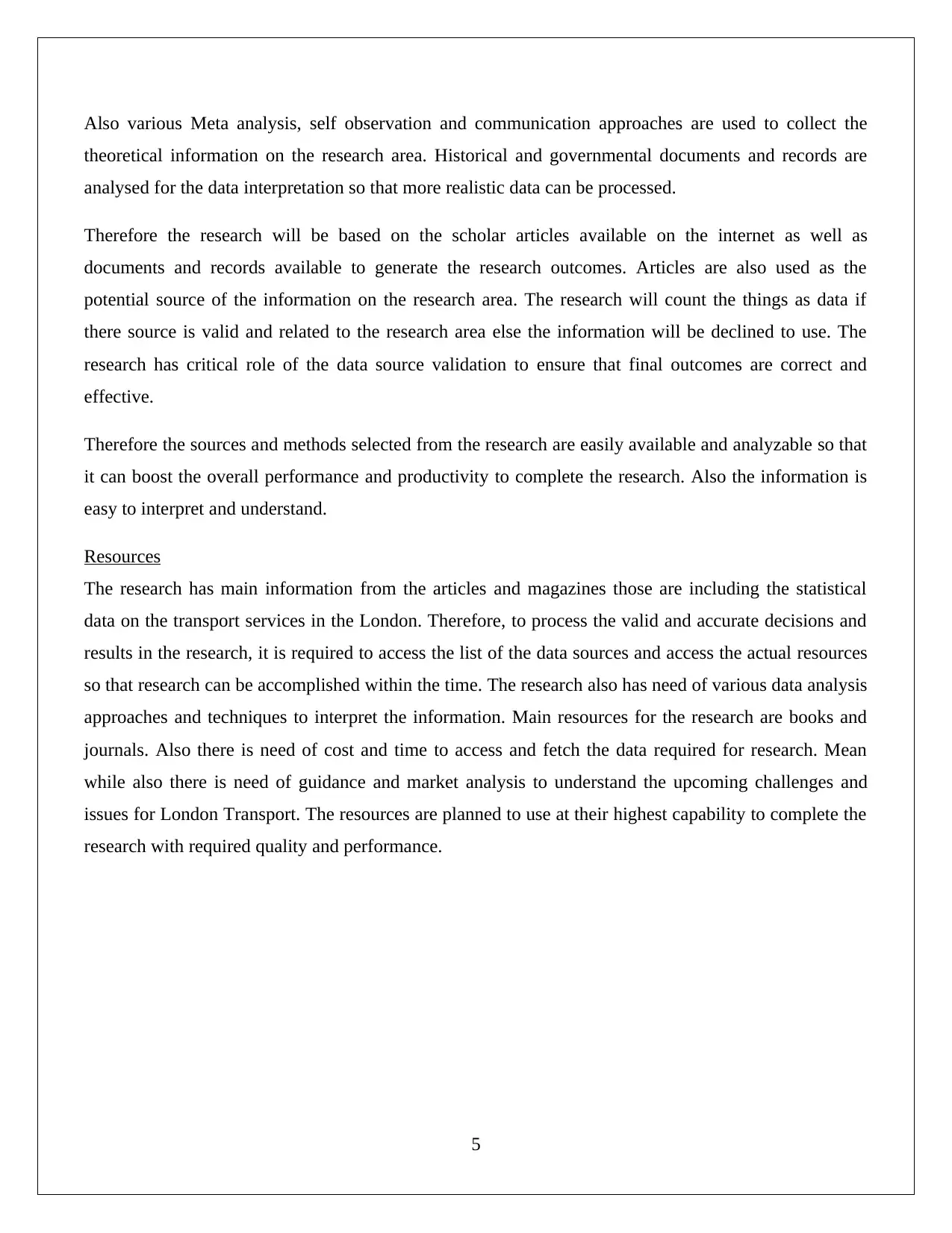
Also various Meta analysis, self observation and communication approaches are used to collect the
theoretical information on the research area. Historical and governmental documents and records are
analysed for the data interpretation so that more realistic data can be processed.
Therefore the research will be based on the scholar articles available on the internet as well as
documents and records available to generate the research outcomes. Articles are also used as the
potential source of the information on the research area. The research will count the things as data if
there source is valid and related to the research area else the information will be declined to use. The
research has critical role of the data source validation to ensure that final outcomes are correct and
effective.
Therefore the sources and methods selected from the research are easily available and analyzable so that
it can boost the overall performance and productivity to complete the research. Also the information is
easy to interpret and understand.
Resources
The research has main information from the articles and magazines those are including the statistical
data on the transport services in the London. Therefore, to process the valid and accurate decisions and
results in the research, it is required to access the list of the data sources and access the actual resources
so that research can be accomplished within the time. The research also has need of various data analysis
approaches and techniques to interpret the information. Main resources for the research are books and
journals. Also there is need of cost and time to access and fetch the data required for research. Mean
while also there is need of guidance and market analysis to understand the upcoming challenges and
issues for London Transport. The resources are planned to use at their highest capability to complete the
research with required quality and performance.
5
theoretical information on the research area. Historical and governmental documents and records are
analysed for the data interpretation so that more realistic data can be processed.
Therefore the research will be based on the scholar articles available on the internet as well as
documents and records available to generate the research outcomes. Articles are also used as the
potential source of the information on the research area. The research will count the things as data if
there source is valid and related to the research area else the information will be declined to use. The
research has critical role of the data source validation to ensure that final outcomes are correct and
effective.
Therefore the sources and methods selected from the research are easily available and analyzable so that
it can boost the overall performance and productivity to complete the research. Also the information is
easy to interpret and understand.
Resources
The research has main information from the articles and magazines those are including the statistical
data on the transport services in the London. Therefore, to process the valid and accurate decisions and
results in the research, it is required to access the list of the data sources and access the actual resources
so that research can be accomplished within the time. The research also has need of various data analysis
approaches and techniques to interpret the information. Main resources for the research are books and
journals. Also there is need of cost and time to access and fetch the data required for research. Mean
while also there is need of guidance and market analysis to understand the upcoming challenges and
issues for London Transport. The resources are planned to use at their highest capability to complete the
research with required quality and performance.
5
Paraphrase This Document
Need a fresh take? Get an instant paraphrase of this document with our AI Paraphraser
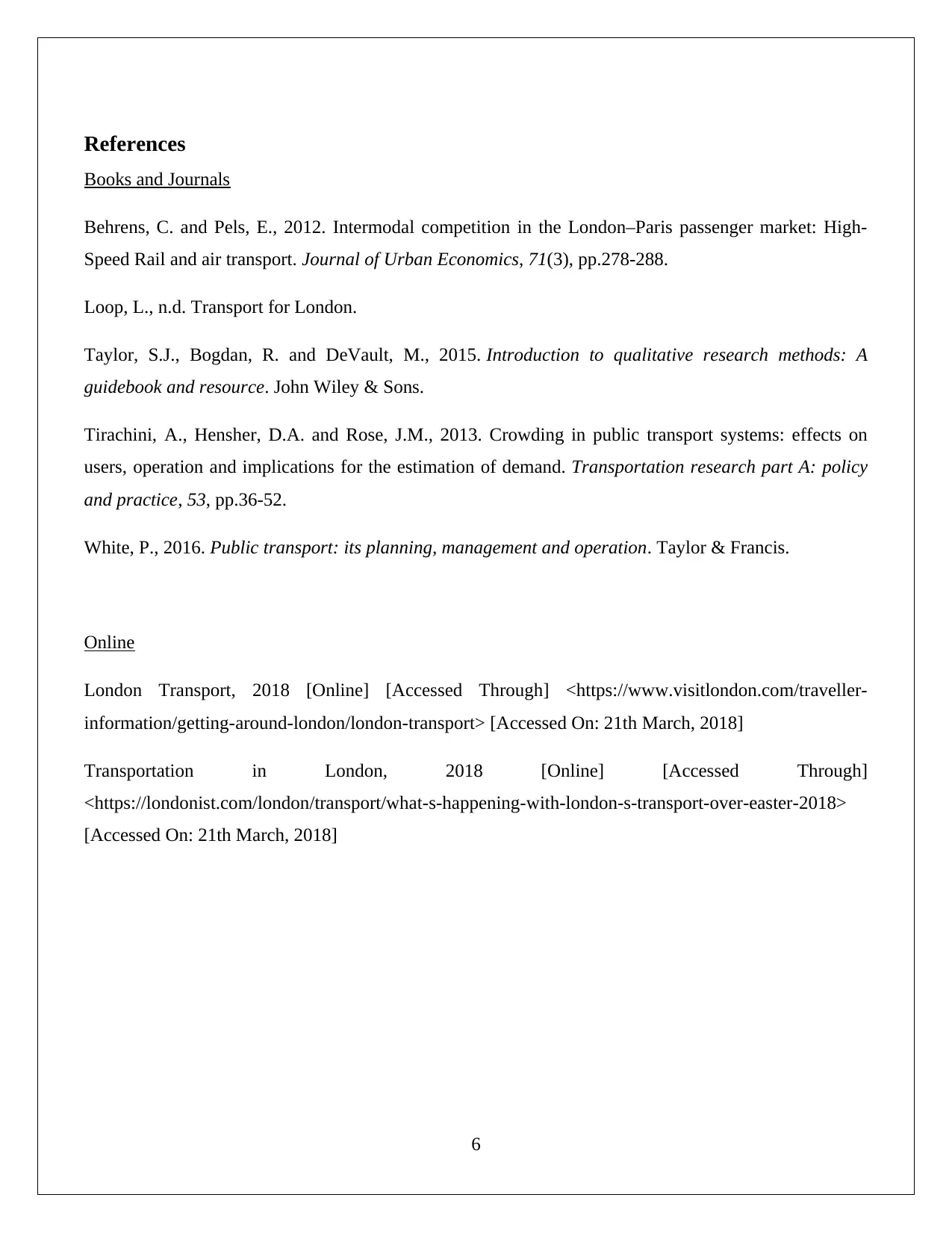
References
Books and Journals
Behrens, C. and Pels, E., 2012. Intermodal competition in the London–Paris passenger market: High-
Speed Rail and air transport. Journal of Urban Economics, 71(3), pp.278-288.
Loop, L., n.d. Transport for London.
Taylor, S.J., Bogdan, R. and DeVault, M., 2015. Introduction to qualitative research methods: A
guidebook and resource. John Wiley & Sons.
Tirachini, A., Hensher, D.A. and Rose, J.M., 2013. Crowding in public transport systems: effects on
users, operation and implications for the estimation of demand. Transportation research part A: policy
and practice, 53, pp.36-52.
White, P., 2016. Public transport: its planning, management and operation. Taylor & Francis.
Online
London Transport, 2018 [Online] [Accessed Through] <https://www.visitlondon.com/traveller-
information/getting-around-london/london-transport> [Accessed On: 21th March, 2018]
Transportation in London, 2018 [Online] [Accessed Through]
<https://londonist.com/london/transport/what-s-happening-with-london-s-transport-over-easter-2018>
[Accessed On: 21th March, 2018]
6
Books and Journals
Behrens, C. and Pels, E., 2012. Intermodal competition in the London–Paris passenger market: High-
Speed Rail and air transport. Journal of Urban Economics, 71(3), pp.278-288.
Loop, L., n.d. Transport for London.
Taylor, S.J., Bogdan, R. and DeVault, M., 2015. Introduction to qualitative research methods: A
guidebook and resource. John Wiley & Sons.
Tirachini, A., Hensher, D.A. and Rose, J.M., 2013. Crowding in public transport systems: effects on
users, operation and implications for the estimation of demand. Transportation research part A: policy
and practice, 53, pp.36-52.
White, P., 2016. Public transport: its planning, management and operation. Taylor & Francis.
Online
London Transport, 2018 [Online] [Accessed Through] <https://www.visitlondon.com/traveller-
information/getting-around-london/london-transport> [Accessed On: 21th March, 2018]
Transportation in London, 2018 [Online] [Accessed Through]
<https://londonist.com/london/transport/what-s-happening-with-london-s-transport-over-easter-2018>
[Accessed On: 21th March, 2018]
6
1 out of 8
Related Documents
Your All-in-One AI-Powered Toolkit for Academic Success.
+13062052269
info@desklib.com
Available 24*7 on WhatsApp / Email
![[object Object]](/_next/static/media/star-bottom.7253800d.svg)
Unlock your academic potential
© 2024 | Zucol Services PVT LTD | All rights reserved.





